The Microsoft Surface Laptop 3 Showdown: AMD's Ryzen Picasso vs. Intel's Ice Lake
by Brett Howse & Andrei Frumusanu on December 13, 2019 8:30 AM ESTSystem Performance
Moving on from SPEC to some of our more traditional laptop tests, I’ve taken the opportunity to add some new tests to the suite, which we’ll include on all laptops going forward. While SPEC is a fantastic set of tests to probe the limits of a platform, not everyone is going to run a workload that runs at nearly 100% CPU utilization for such a long time on a laptop. The 8-Thread tests took 4.5 hours to complete on Ice Lake, and 6.5 hours to complete on Picasso, which is likely not something most people would turn to a thin and light laptop for, so it’s important to see how both platforms perform on shorter tests where they can leverage their peak boost frequencies for a higher percentage of the duration.
PCMark 10
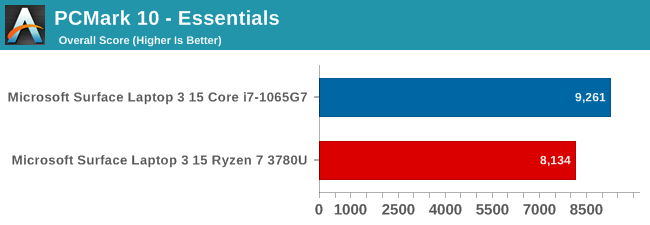

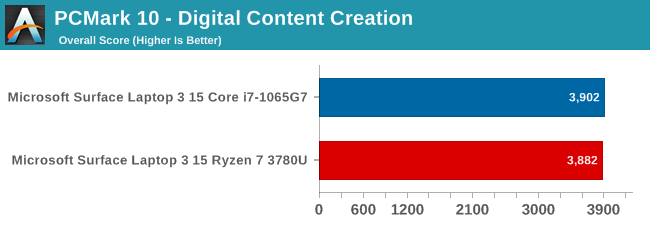
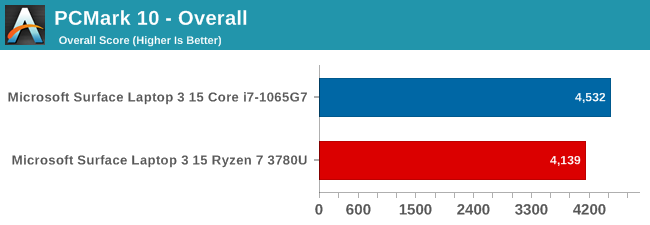
PCMark 10 consists of several real-world tests, including web, video conferencing, spreadsheets, writing, and more. There are several GPU tests as well, including rendering, and some gaming. The suite also measures application start-up, and all aspects of the system’s performance factor into the score.
Intel’s CPU performance lead shows clearly here again, with significant leads in both the Essentials and Productivity tests, although AMD’s strong GPU pulls the Ryzen system very close on the Digital Content Creation tasks. But that is not enough to turn the tide, and the Ice Lake platform carries this win.
Cinebench R20
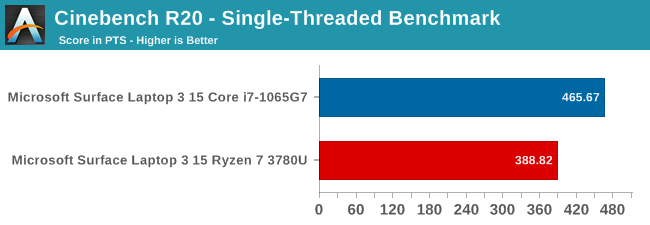
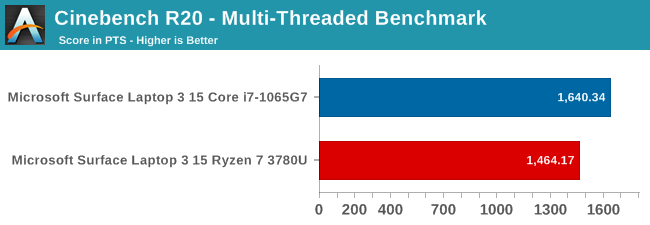
Looking at the latest version of Cinebench tells a similar story as to what we’ve seen so far. Ice Lake’s significant IPC lead pulls it way ahead. On the multi-threaded test, the AMD platform does close the gap somewhat, which is similar to the SPEC rate 8 results.
7-Zip
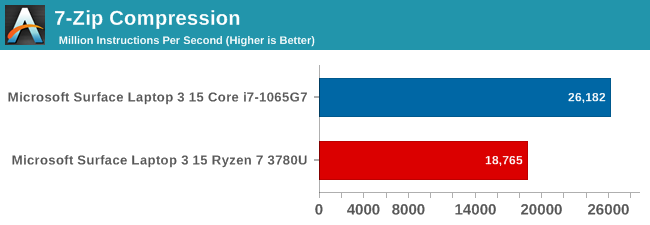
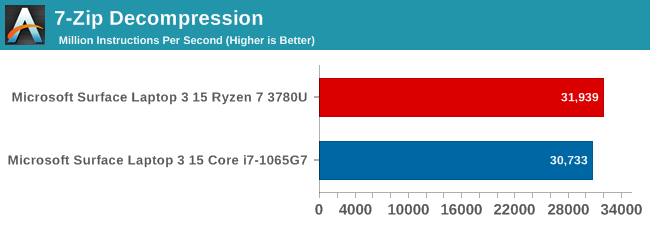
Checking out the popular 7-Zip file compression tool, the results are in-line with what we see in the desktop space. Intel generally has a lead on the compression side, but AMD claws back at decompression. It is a rare win on the CPU side for AMD here.
Handbrake
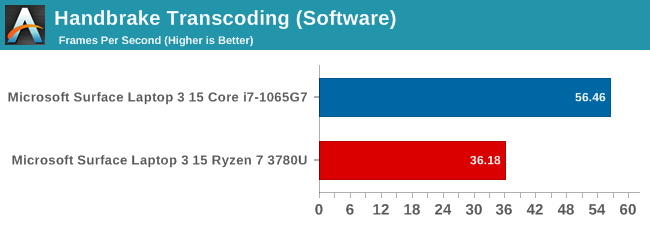
Transcoding is a popular task, and Handbrake is one of the most popular tools. For this test, a 1080p movie is converted to 720p using the x264 encoder. Once again, Ice Lake offers significantly more performance when transcoding in software.

Handbrake also supports various hardware encoders, such as Intel’s QuickSync, which provides significantly quicker transcodes at the same settings – albeit at larger file sizes and slightly lower quality compared to the software transcode, according to the Handbrake documentation. QuickSync has been very popular, and has been around quite a while. AMD also offers hardware encoding and decoding with their Video Core Next platform. Handbrake does support AMD’s Video Coding Engine (VCE) but the Surface Laptop 3 does not offer this as an option in Handbrake, so it was not able to be tested. As this is the only current Ryzen mobile APU we’ve tested, it may be a driver issue specific to the Surface branded processor.
x264
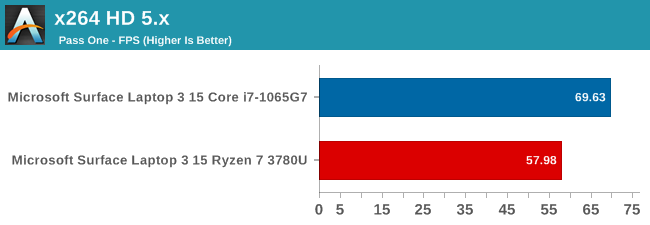
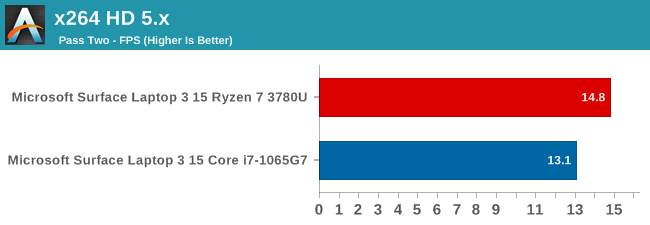
Our previous transcoding test, x264, was also run. Here we see that once again Ice Lake has a significant performance advantage, as it did with Handbrake software encoding.
Web Tests
All of our web tests were run with the current version of Microsoft Edge in Windows 10 1909. Web results are highly impacted by the underlying scripting engine, and Microsoft is going to be moving Edge from the EdgeHTML rendering engine to the Chromium open-source project that powers Google Chrome. When they make this change, expected early in 2020, we’ll revamp our suite with new tests.
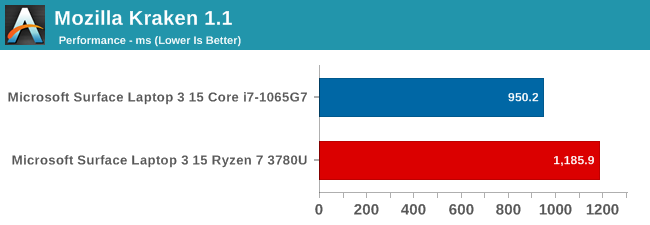

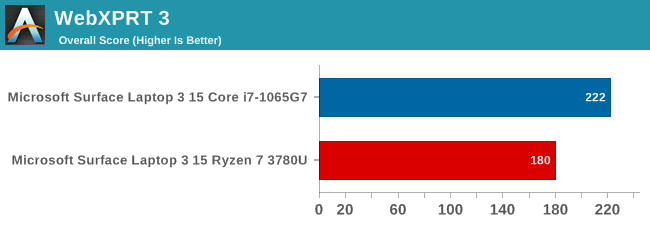
Intel has aggressively pushed their frequency ramping with Speed Shift, and one of the biggest beneficiaries of Speed Shift is web scripting, since the tasks tend to be very short. AMD is addressing this in Zen 2 with Collaborative Power Performance Control 2, or CPPC2, which is not as elegant of a name as Speed Shift, but promises to drop Zen’s frequency ramping from ~30 ms to ~1 to 2 ms, and will be a welcome addition on our web tests.










174 Comments
View All Comments
Cliff34 - Saturday, December 14, 2019 - link
I agree. AMD won't be able to compete w Intel until AMD focuses on building cpus for laptops.generalako - Monday, December 16, 2019 - link
Ehhh, Sunny Cove's successor will bring an equal IPC increase, from what Intel has stated.AMD has themselves to blame. Why tf would you delay the architecture of both GPU and CPU and process node as well like that? I mean, the money lost from doing that, as OEMs will have little reason to move away from Intel's superior products, outweighs the money "saved" from this delay, no? Not like a Zen 2 APU won't come anyway, so why not do it before rather than after?
If AMD are smart they'll jump one architecture ahead. Starting with Zen 4 in 1.5 year's time, they should be smart enough to jump straight from Zen 2 APU to Zen 4.
Korguz - Monday, December 16, 2019 - link
generalako " Ehhh, Sunny Cove's successor will bring an equal IPC increase, from what Intel has stated. " and you believe intel ???cheshirster - Tuesday, December 31, 2019 - link
"Sunny Cove's successor will bring an equal IPC increase, from what Intel has stated"They never stated that.
Qasar - Wednesday, January 1, 2020 - link
heh... yea right.. until its proven, just another lie from intel to keep their investors and shareholders happy....azazel1024 - Monday, December 16, 2019 - link
I don't think it is just the IPC boost. The two chips in the comparison here had memory bandwidth differences of 80%!Simply looking at a few of the SPEC INT tests, that was very clear that if AMD even on Zen had similar memory bandwidth to the Ice Lake chip, it likely would have been spitting distance. GPU workloads are also very heavily memory bandwidth constrained and AMD's Vega here was slightly ahead of Intel. If it had 80% higher memory bandwidth it probably would have been 20-30% faster in many of those games/benchmarks.
Even some of the not heavily memory constrained workloads like Handbrake, faster memory does improve performance. That 80% memory bandwidth difference may well have been a 5-8% performance hit to AMD.
BUT AMD shipped it with only DDR4-2400 support. It is the chip they brought to the fight.
If their Zen 2 manages to both have lower platform power (doesn't need to be parity with Intel or better, but 10% better would go a huge long way towards making it less of a decision for a lot of people), brings its 15% better IPC and if it keeps its clock speeds AND manages to bring DDR4L-3000/DDR4x-3760 or whatever compatibility and suspect Intel is done for in the laptop space.
That should give AMD several more wins in CPU performance, bring it to parity or near parity in most of the others leaving Intel with only a few wins in that. For GPU performance, AMD wouldn't even really need to update the iGPU. Just give it that extra bandwidth and Zen 2 CPU behind it and it likely would be kicking Intel's butt by 20-40%. Upgraded on top of having that, yes please.
qap - Saturday, December 14, 2019 - link
I don't think it is about IPC or CPU power anymore. Yes, AMD is slower, but not in a way that would bother me. It is more about power management that is and always was sore spot of AMD in notebooks.And no - 7nm is not the solution unfortunately. It may help under load, but under standby it can actually hurt battery life (leakage is higher). Most improvements in battery life are done by architectural changes (more specialized units, powering down unused parts etc).
nico_mach - Tuesday, December 17, 2019 - link
Well, this driver is still under development and in the first test, they were running cooler than Intel, so likely there is tuning to be done, still. They just haven't done much laptop work in recent years. They're going to be behind on more than the hardware, which is why Microsoft's involvement is really promising, really. Of course they still have some minor hardware matters to sort out, as you point out.Rezurecta - Friday, December 13, 2019 - link
Do you think a lot of help came from the sizeable memory speed differences? Do you think it benefitted cpu or gpu more? Is there a way to underclock the Intel memory so you can see the differences that the memory brings?Thank you.
ikjadoon - Friday, December 13, 2019 - link
It's perplexing: AMD created an entirely new SKU for Microsoft (the AMD RYZEN™ 7 3780U Microsoft Surface® Edition Processor), but AMD still left this CU 11-equipped iGPU at the barebones 2400 MHz speed.Why not rate this MS-only SKU at 2933MHz or 3200MHz? My only thought: high-speed DDR4 was just going to exacerbate AMD's already-too-large power consumption.